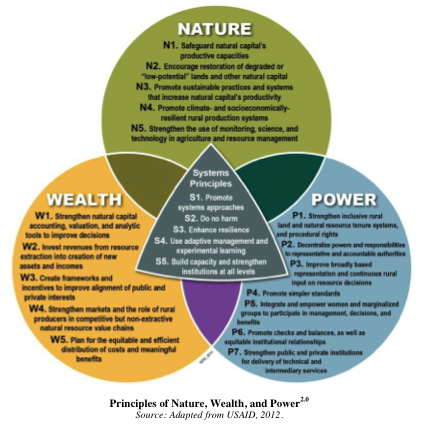Feb. 4, 2014 – Hilary O. Faxon
“Nature, Wealth, & Power 2.0” might just be the sexiest title ever used by the U.S. Federal Government. It also happens to contain sound development guidance. The new USAID publication lays out a conceptual framework for integrating governance, economic, and environmental considerations into development programs, promoting a systems approach that transcends disciplinary boundaries.
Each section – “Nature,” “Wealth,” “Power,” and “Systems” – explores core principles and actions to guide diverse development projects. The publication draws from field experiences of a decade of projects, incorporating case studies and expanding from the 2002 NWP1. The result is a relatively straightforward report that not only promotes and illustrates the concept, but also provides guidelines to make it operational. Agronomists, conservationists, economists, anthropologists, attorneys, and development practitioners alike can find their spot on the best venn diagram since 5th grade.
When looking at development processes, “cause and effect often fall in different sectors,” said Asif Shaikh, Senior Advisor for the Center for Strategic and International Studies and an author behind NWP1. The original team began work with the observation that many of the world’s disenfranchised people are linked with environmental degradation; eventually they came to see nature, wealth, and power as inextricably and inevitably linked. At NWP2.0’s launch event last week in Washington, D.C., Shaikh remembered explaining the concept to a local government leader in West Africa, who immediately responded, “Of course: the people need the power to manage the resources to create the wealth.”
The power of these linkages is demonstrated in the so-called “global land grab,” an uptick in corporate and federal usurpation of local land rights. In Myanmar, the recent influx of Foreign Direct Investment for mega-agriculture plantations and energy projects in a context of weak governance and ethnic strife has led to mass displacement. In Honduras, drug trafficking and desperate poverty in the absence of rule of law, education, and economic opportunity feed forest degradation. These complex cases only begin to unravel with understanding of global markets, domestic laws and institutions, and the characteristics of local land use and natural resources.
The NWP ideas are not new, but they are important to comprehensively and officially state (practice does not always follow principles, and major development donors have been guilty of neglecting or blatantly disregarding social and environmental safeguards). In sticking close to tried-and-true development success stories – pastoralists conserve Kenya; community forests empower Nepalis – the publication misses an opportunity to apply the NWP framework to critical issues including health, infrastructure, and cities – the last is especially critical as the global population tips towards majority urban. Still, a more proactive and sophisticated understanding of social and environmental systems from an aid organization is a step in the right direction, and an especially big step given USAID’s proposed 2014 budget of $20.4 billion. NWP has grown from niche idea to compelling theory; if it can become the foundation of standard development practice, the planet and its poor will be better for it.
Credit for image: here.

